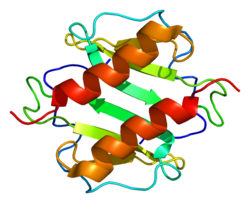CXCL1
Phối tử chemokine (mô-típ CXC) 1 (CXCL1) là một cytokine nhỏ thuộc họ chemokine CXC trước đây được gọi là GRO1 oncogene, GROα, KC, protein kích hoạt tăng bạch cầu trung tính 3 (NAP-3) MGSA-α). Ở người, protein này được mã hóa bởi CXCL1.[3]
Chức năng sửa
CXCL1 được tiết ra bởi các tế bào u ác tính ở người, có đặc tính giảm thiểu và có liên quan đến sinh bệnh u ác tính.[4][5] CXCL1 được thể hiện bởi các đại thực bào, bạch cầu trung tính và tế bào biểu mô,[6][7] và có hoạt tính hóa học bạch cầu trung tính.[8][9] CXCL1 đóng một vai trò trong sự phát triển tủy sống bằng cách ức chế sự di chuyển của tiền chất oligodendrocyte và tham gia vào các quá trình tạo mạch, sinh động mạch, viêm, chữa lành vết thương và sinh khối u.[10][11][12][13] Chemokine này gợi ra tác dụng của nó bằng cách truyền tín hiệu qua thụ thể chemokine CXCR2. Gen cho CXCL1 nằm trên nhiễm sắc thể 4 ở người trong số các gen của các chemokine CXC khác.[14] Một nghiên cứu ban đầu trên chuột cho thấy bằng chứng cho thấy CXCL1 đã giảm mức độ nghiêm trọng của bệnh đa xơ cứng và có thể có chức năng bảo vệ thần kinh.[15]
Tham khảo sửa
- ^ a b c GRCh38: Ensembl release 89: ENSG00000163739 - Ensembl, May 2017
- ^ “Human PubMed Reference:”.
- ^ Haskill S, Peace A, Morris J, Sporn SA, Anisowicz A, Lee SW, Smith T, Martin G, Ralph P, Sager R (tháng 10 năm 1990). “Identification of three related human GRO genes encoding cytokine functions”. Proc. Natl. Acad. Sci. U.S.A. 87 (19): 7732–6. Bibcode:1990PNAS...87.7732H. doi:10.1073/pnas.87.19.7732. PMC 54822. PMID 2217207.
- ^ Anisowicz A, Bardwell L, Sager R (tháng 10 năm 1987). “Constitutive overexpression of a growth-regulated gene in transformed Chinese hamster and human cells”. Proc. Natl. Acad. Sci. U.S.A. 84 (20): 7188–92. Bibcode:1987PNAS...84.7188A. doi:10.1073/pnas.84.20.7188. PMC 299255. PMID 2890161.
- ^ Richmond A, Thomas HG (tháng 2 năm 1988). “Melanoma growth stimulatory activity: isolation from human melanoma tumors and characterization of tissue distribution”. J. Cell. Biochem. 36 (2): 185–98. doi:10.1002/jcb.240360209. PMID 3356754.
- ^ Iida N, Grotendorst GR (tháng 10 năm 1990). “Cloning and sequencing of a new gro transcript from activated human monocytes: expression in leukocytes and wound tissue”. Mol. Cell. Biol. 10 (10): 5596–9. doi:10.1128/mcb.10.10.5596. PMC 361282. PMID 2078213.
- ^ Becker S, Quay J, Koren HS, Haskill JS (tháng 3 năm 1994). “Constitutive and stimulated MCP-1, GRO alpha, beta, and gamma expression in human airway epithelium and bronchoalveolar macrophages”. Am. J. Physiol. 266 (3 Pt 1): L278–86. doi:10.1152/ajplung.1994.266.3.L278. PMID 8166297.
- ^ Moser B, Clark-Lewis I, Zwahlen R, Baggiolini M (tháng 5 năm 1990). “Neutrophil-activating properties of the melanoma growth-stimulatory activity”. J. Exp. Med. 171 (5): 1797–802. doi:10.1084/jem.171.5.1797. PMC 2187876. PMID 2185333.
- ^ Schumacher C, Clark-Lewis I, Baggiolini M, Moser B (tháng 11 năm 1992). “High- and low-affinity binding of GRO alpha and neutrophil-activating peptide 2 to interleukin 8 receptors on human neutrophils”. Proc. Natl. Acad. Sci. U.S.A. 89 (21): 10542–6. doi:10.1073/pnas.89.21.10542. PMC 50375. PMID 1438244.
- ^ Tsai HH, Frost E, To V, Robinson S, Ffrench-Constant C, Geertman R, Ransohoff RM, Miller RH (tháng 8 năm 2002). “The chemokine receptor CXCR2 controls positioning of oligodendrocyte precursors in developing spinal cord by arresting their migration”. Cell. 110 (3): 373–83. doi:10.1016/S0092-8674(02)00838-3. PMID 12176324.
- ^ Vries MH, Wagenaar A, Verbruggen SE, Molin DG, Dijkgraaf I, Hackeng TH, Post MJ (tháng 4 năm 2015). “CXCL1 promotes arteriogenesis through enhanced monocyte recruitment into the peri-collateral space”. Angiogenesis. 18 (2): 163–71. doi:10.1007/s10456-014-9454-1. PMID 25490937.
- ^ Devalaraja RM, Nanney LB, Du J, Qian Q, Yu Y, Devalaraja MN, Richmond A (tháng 8 năm 2000). “Delayed wound healing in CXCR2 knockout mice”. J. Invest. Dermatol. 115 (2): 234–44. doi:10.1046/j.1523-1747.2000.00034.x. PMC 2664868. PMID 10951241.
- ^ Owen JD, Strieter R, Burdick M, Haghnegahdar H, Nanney L, Shattuck-Brandt R, Richmond A (tháng 9 năm 1997). “Enhanced tumor-forming capacity for immortalized melanocytes expressing melanoma growth stimulatory activity/growth-regulated cytokine beta and gamma proteins”. Int. J. Cancer. 73 (1): 94–103. doi:10.1002/(SICI)1097-0215(19970926)73:1<94::AID-IJC15>3.0.CO;2-5. PMID 9334815.
- ^ Richmond A, Balentien E, Thomas HG, Flaggs G, Barton DE, Spiess J, Bordoni R, Francke U, Derynck R (tháng 7 năm 1988). “Molecular characterization and chromosomal mapping of melanoma growth stimulatory activity, a growth factor structurally related to beta-thromboglobulin”. EMBO J. 7 (7): 2025–33. doi:10.1002/j.1460-2075.1988.tb03042.x. PMC 454478. PMID 2970963.
- ^ Omari KM, Lutz SE, Santambrogio L, Lira SA, Raine CS (tháng 1 năm 2009). “Neuroprotection and remyelination after autoimmune demyelination in mice that inducibly overexpress CXCL1”. Am. J. Pathol. 174 (1): 164–76. doi:10.2353/ajpath.2009.080350. PMC 2631329. PMID 19095949.
Liên kết ngoài sửa
- Vị trí bộ gen CXCL1 ở người và thông tin chi tiết về gen CXCL1 có sẵn trên UCSC Genome Browser.


